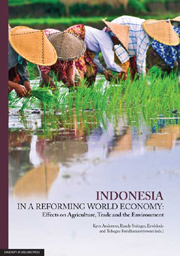Book contents
- Frontmatter
- Contents
- List of tables, figures and boxes
- FIGURES
- Acronyms
- Preface
- List of contributors
- 1 Introduction
- 2 Effects of growth, its interruption, and the Uruguay Round on Indonesian agriculture
- 3 Effects of AFTA and APEC trade policy reforms on Indonesian agriculture
- 4 Trade liberalisation and soil degradation in Indonesia
- 5 Will the Uruguay Round and APEC reforms harm air and water quality in Indonesia?
- 6 Impacts of agricultural protection growth at home and the WTO's Doha Round on Indonesian agriculture
- 7 Effects of agricultural policy reform on household and regional income distribution in Indonesia
- 8 Effects of farm policy reform on Indonesia's secondary food crops
- 9 Effects of agricultural policy reform in Indonesia on its food security and environment
- 10 Impacts of trade policy reform on income distribution and poverty in Indonesia
- APPENDIX 1 The WAYANG Model of the Indonesian economy
- APPENDIX 2 The GTAP Model and database
2 - Effects of growth, its interruption, and the Uruguay Round on Indonesian agriculture
Published online by Cambridge University Press: 05 June 2012
- Frontmatter
- Contents
- List of tables, figures and boxes
- FIGURES
- Acronyms
- Preface
- List of contributors
- 1 Introduction
- 2 Effects of growth, its interruption, and the Uruguay Round on Indonesian agriculture
- 3 Effects of AFTA and APEC trade policy reforms on Indonesian agriculture
- 4 Trade liberalisation and soil degradation in Indonesia
- 5 Will the Uruguay Round and APEC reforms harm air and water quality in Indonesia?
- 6 Impacts of agricultural protection growth at home and the WTO's Doha Round on Indonesian agriculture
- 7 Effects of agricultural policy reform on household and regional income distribution in Indonesia
- 8 Effects of farm policy reform on Indonesia's secondary food crops
- 9 Effects of agricultural policy reform in Indonesia on its food security and environment
- 10 Impacts of trade policy reform on income distribution and poverty in Indonesia
- APPENDIX 1 The WAYANG Model of the Indonesian economy
- APPENDIX 2 The GTAP Model and database
Summary
All of the forward-looking analyses of East Asia's economies of the decade or so to mid-1997 had been premised on the assumption that rapid national output and trade growth would continue. The dramatic withdrawal of financial capital from the region and the crash in the value of local currencies from late 1997 meant that such analyses needed to be revised. How much difference would a few years of GDP decline in Indonesia and other East Asian economies make to projections of structural change in Indonesia, for example? Might we even see a re-agriculturalisation of the economy? In particular, how will the crisis alter the expected effects on Indonesia of implementation of the Uruguay Round, and hence attitudes towards the efficacy of that and other economic policy reforms?
To help answer these questions, this chapter uses a global, economywide model known as GTAP (Hertel 1997). That model was used recently to project the implications of economic growth and Uruguay Round trade policy reform at home and abroad for the structure of Indonesia's economy over the period to 2005 (Anderson and Pangestu 1998). We extend that work to consider the impact of an interruption to growth due to the current economic and financial crisis. We begin by modelling the effect of the growth interruption on the economy in 2005 without and then with Uruguay Round implementation. We then simulate two alternative possible trade policy responses to the crisis: either that Indonesia chooses to slow its trade reform program, or that it chooses to liberalise its markets even further than it is currently committed to under the Uruguay Round.
- Type
- Chapter
- Information
- Indonesia in a Reforming World EconomyEffects on Agriculture, Trade and the Environment, pp. 10 - 27Publisher: The University of Adelaide PressPrint publication year: 2009



